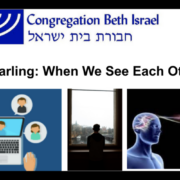When We See Each Other: a d’varling for Shabbat Shuvah
Ordinarily on Shabbat Shuvah I would talk about teshuvah, return — turning our lives around, returning to our Source and to our highest selves. This is, after all, the work of the season. But I think that in this second pandemic year, there’s no shortage of time for introspection — a lot of us have been too alone, or turning too inward. So instead I want to talk today about what connects us with each other, and what it might mean to return to each other and to community.
Over the summer I had the opportunity to co-teach a pioneering rabbinic school class on doing Jewish digitally, with my friend and frequent collaborator Rabbi David Markus. We covered a lot of ground, ranging from the nature of prayer and ritual, to wise use of visuality, to creating spiritual and tangible “runways” into the digital ritual experience. And in one of our sessions, we opened with some classical texts about what makes a minyan.
Rambam wrote in the 1170s that “[c]ommunal prayer always is heard [by God]. … Thus, one must join oneself with the community, and never pray alone whenever one is able to pray with the community.” (Mishneh Torah, Prayer 8:1.) This is part of Judaism’s fundamental communitarianism. Can one talk to God alone? Of course! But it’s not good to separate oneself from community. The community needs us to show up, because in coming together to make a minyan, we also come together to make community.
Alongside that, we studied a text from the Shulhan Arukh, written in 1563 by Joseph Karo:
All 10 must be in one place, and the prayer-leader with them…One standing behind the synagogue, and in-between them is a window – even if it is several stories high … – and [whose] face is visible to them from there, joins them to make 10. If a few of them are inside and a few are outside, and the prayer-leader is in the doorway, the prayer-leader connects them [into one minyan]. (O.C. 55:13-15)
The simplest way to make a minyan is ten people in one place, including the prayer-leader. That seems pretty clear. But then he goes on to say: if one person is outside the room, but can be seen from inside, that person can be included. And if some are in one space and some are in another, they can all be included. So long as the prayer leader can see them, that being-seen connects them into one community, even if they can’t all see each other.
As soon as I read that, I thought: welcome to Zoom / hybrid / digital services, y’all.
Joseph Karo could not have imagined Zoom services or the hybrid services we’ve been holding all summer, with some participating onsite and others participating online. But he was already wrestling with this question that’s live for us now: how do we create sacred community when we’re not all in the same physical place?
For Karo, community arises when we can see each other. If I lead a service and it’s broadcast on television, the people watching it might or might not have a meaningful experience — but they can’t be counted in a minyan together, because there’s no two-way connectivity. I can’t see them, and they can’t see each other. I think he’s right, which is why I’ve made a practice of including periodic “face to face” slides where we stop the screenshare and meet each others’ eyes.
I think he’s on to something in a deeper spiritual sense, too. What makes us a community is not whether or not we can convene to pray in the same room at the same time… because if that were the case, then anyone who doesn’t show up to pray ceases to be part of the community! and if that were the case, then our community would have evaporated when the pandemic hit and we, along with so many others, started sheltering in place at home.
We become community when we see each other. I would go further: we become community not just when we glance at each others’ faces, but when we try to see each other fully. When we see what matters to each other. When we see what enlivens each other. When we see not only each others’ faces but each others’ hearts.
It turns out that when we see each other, something in us changes. Mirror neurons are brain cells that fire their electrical pulses both when we do a thing, and when we see someone else do that same thing. This was first observed in monkeys in an Italian lab some thirty years ago: electrodes in their brains showed neurons firing when they handled food, and when they saw someone else handle food — even when they merely heard the sounds of food being handled outside of their line of sight. Some researchers think that mirror neurons explain why we can have strong emotional reaction to characters on TV or in movies: because when we see them, we feel-with-them.
Being together on Zoom is not the same as being together onsite. We can’t sing in harmony on Zoom, or hug each other, or have that feeling of being together in a room. But when we see each other, our mirror neurons still work their magic.
For Joseph Karo, one of the roles of the shaliach tzibbur (the prayer leader) is to see all the souls in the room — and in seeing them, to constitute them into community. This is not a rabbinic job per se. Any adult Jew who learns the liturgy can lead the community in prayer. And any one of us who makes an effort to really see the other souls in the room can create some of the cohesion that makes us a community.
As you’ve heard me say several times this year, our theme for this year’s Days of Awe is gevurah, which means strength and power. It means boundaries. It evokes resilience and courage, too. It takes gevurah to really see each other, to be mindful of where I end and where you begin, to honor our differences without diminishing what connects us. It takes gevurah to connect with each other in these pandemic times when we may feel overwhelmed or despairing, or we may find the technologies of Zoom opaque. It takes gevurah to create community.
An invitation: to see each other deeply.
To awaken our mirror neurons as we see each other.
To create community together by seeing each other where we are, as we are, in all that we are.
Cross-posted to Velveteen Rabbi.






